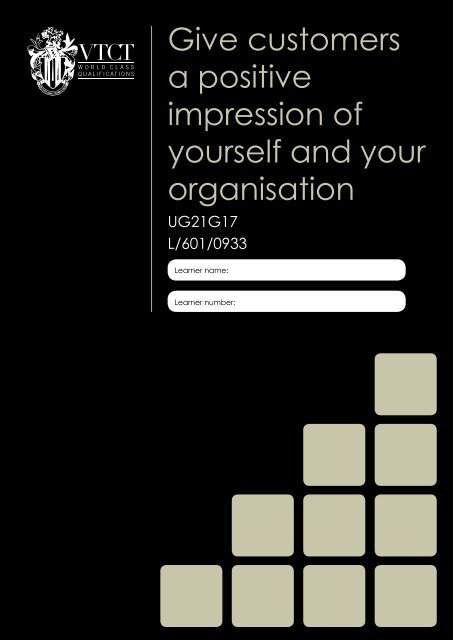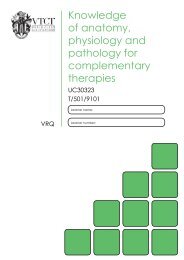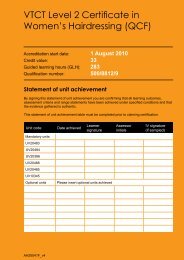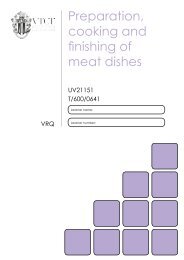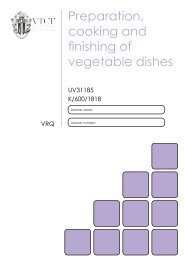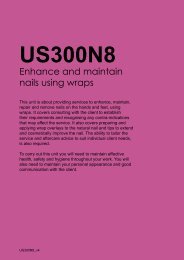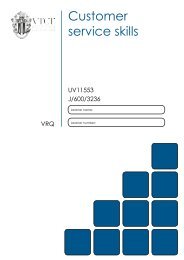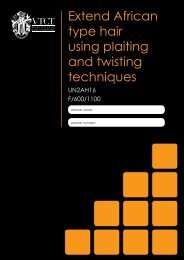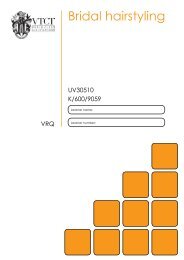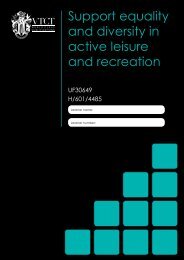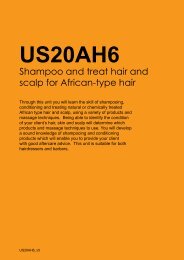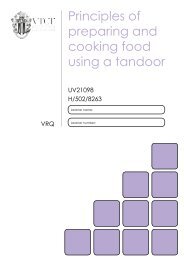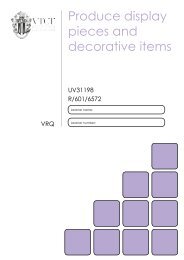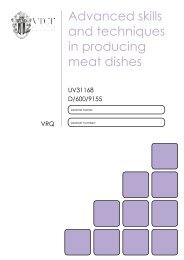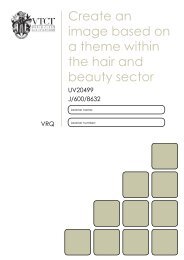UG21G17 - VTCT
UG21G17 - VTCT
UG21G17 - VTCT
Create successful ePaper yourself
Turn your PDF publications into a flip-book with our unique Google optimized e-Paper software.
Give customers<br />
a positive<br />
impression of<br />
yourself and your<br />
organisation<br />
<strong>UG21G17</strong><br />
L/601/0933<br />
Learner name:<br />
Learner number:
Statement of unit achievement<br />
<strong>VTCT</strong> is the specialist awarding body for the Hairdressing, Beauty Therapy,<br />
Complementary Therapy and Sport and Active Leisure sectors, with over 45<br />
years of experience.<br />
<strong>VTCT</strong> is an awarding body regulated by national organisations including<br />
Ofqual, SQA, DCELLS and CCEA.<br />
<strong>VTCT</strong> is a registered charity investing in education and skills but also giving to<br />
good causes in the area of facial disfigurement.<br />
By signing this statement of unit achievement you are confirming that all learning outcomes, assessment<br />
criteria and range statements have been achieved under specified conditions and that the evidence<br />
gathered is authentic.<br />
This statement of unit achievement table must be completed prior to claiming certification.<br />
Unit code Date achieved Learner signature<br />
Assessor tracking table<br />
Assessor name Assessor signature<br />
Assessor<br />
initials<br />
Assessors<br />
initials<br />
IV signature<br />
(if sampled)<br />
All assessors using this Record of Assessment book must complete this table. This is required for<br />
verification purposes.<br />
Assessor number<br />
(optional)
<strong>UG21G17</strong><br />
Give customers a positive<br />
impression of yourself and your<br />
organisation<br />
Excellent customer service is provided by people who are<br />
good with people. Your behaviour affects the impression<br />
that customers form of the service they are receiving.<br />
This unit is all about communicating with customers and<br />
giving a positive impression whenever dealing with a<br />
customer. By doing this you will also be giving a positive<br />
impression of your organisation and the customer service it<br />
provides.<br />
All of us enjoy the experience of good service if we feel<br />
that the person serving us really wants to create the right<br />
impression, respond to us and give us good information.<br />
Every detail of your behaviour when dealing with a<br />
customer counts.<br />
<strong>UG21G17</strong>_v8
NOS<br />
G17<br />
Level<br />
Credit value<br />
GLH<br />
2<br />
5<br />
33<br />
Observations<br />
2<br />
External paper(s)<br />
0<br />
© Habia
Give customers a positive<br />
impression of yourself and your<br />
organisation<br />
Learning outcomes<br />
On completion of this unit you will:<br />
1. Be able to establish rapport with customers<br />
2. Be able to respond appropriately to<br />
customers<br />
3. Be able to communicate information to<br />
customers<br />
4. Know and understand how to give<br />
customers a positive impression of yourself<br />
and the organisation<br />
Evidence requirements<br />
1. Your evidence should be collected when<br />
carrying out a real job, whether paid or<br />
voluntary and when dealing with real clients,<br />
whether internal or external to the salon.<br />
However, for this unit, evidence collected<br />
in a realistic working environment or a work<br />
placement is permissible. Simulation is not<br />
allowed for any performance evidence with<br />
this unit. You may collect the evidence for<br />
the unit through work in a private sector<br />
salon, a not-for-profit salon or a public<br />
services salon.<br />
2. You must provide evidence that shows<br />
you have done this over a sufficient period<br />
of time with different clients on at least 2<br />
different occasions for your assessor to<br />
be confident that you are competent.<br />
3. You must provide evidence of creating a<br />
positive impression with clients:<br />
• during routine delivery of client service<br />
• during a busy period for your salon<br />
• during a quiet period for your salon<br />
• when people, systems or resources have<br />
let you down.<br />
4. You need to prove that you have dealt with<br />
clients who:<br />
• have different needs and expectations<br />
• appear angry or confused<br />
• behave unconventionally.<br />
5. Your evidence must show that you respond<br />
to clients using your salon’s procedures and<br />
guidelines.<br />
6. Your communication with clients may be<br />
face to face, in writing, by telephone, text<br />
message, email, internet, intranet or by any<br />
other method you would be expected to use<br />
within your job role.<br />
7. You must prove that you communicate with<br />
clients effectively by providing evidence that<br />
you:<br />
• use appropriate spoken or written<br />
language<br />
• apply the conventions and rules<br />
appropriate to the method of<br />
communication you have chosen.<br />
8. There is no external paper requirement for<br />
this unit.<br />
<strong>UG21G17</strong><br />
3
4<br />
Achieving observations<br />
and range<br />
Achieving observation outcomes<br />
Your assessor will observe your performance<br />
of practical tasks. The minimum number<br />
of observations required is indicated in the<br />
evidence requirements section of this unit.<br />
Criteria may not always naturally occur during<br />
a practical observation. In such instances you<br />
will be asked questions to demonstrate your<br />
competence in this area. Your assessor will<br />
document the criteria that have been achieved<br />
through oral questioning.<br />
Your assessor will sign off an outcome when all<br />
criteria have been competently achieved in a<br />
single client service.<br />
Achieving range<br />
The range section indicates what must<br />
be covered. Ranges must be practically<br />
demonstrated as part of an observation. Your<br />
assessor will document the portfolio reference<br />
once a range has been competently achieved.<br />
<strong>UG21G17</strong><br />
Maximum service times<br />
There are no maximum service times that apply<br />
to this unit.
Outcome 1<br />
Be able to establish rapport with customers<br />
You can:<br />
a. Meet your organisation’s standards of<br />
appearance and behaviour<br />
b. Greet your customer respectfully and in a<br />
friendly manner<br />
c. Communicate with your customer in a way<br />
that makes them feel valued and respected<br />
d. Identify and confirm your customer’s<br />
expectations<br />
e. Treat your customer courteously and<br />
helpfully at all times<br />
f. Keep your customer informed and<br />
reassured<br />
g. Adapt your behaviour to respond to different<br />
customer behaviour<br />
*May be assessed through oral questioning.<br />
Observations<br />
Observation 1 2<br />
Criteria questioned orally<br />
Date achieved<br />
Portfolio reference<br />
Learner signature<br />
Assessor initials<br />
<strong>UG21G17</strong><br />
5
6<br />
© Habia<br />
Outcome 2<br />
Be able to respond appropriately to customers<br />
You can:<br />
a. Respond promptly to a customer seeking<br />
help *<br />
b. Choose the most appropriate way to<br />
communicate with your customer<br />
c. Check with your customer that they have<br />
fully understood your expectations<br />
d. Respond promptly and positively to your<br />
customer’s questions and comments<br />
e. Allow your customer time to consider your<br />
response and give further explanation when<br />
appropriate<br />
*May be assessed through oral questioning.<br />
Observation 1 2<br />
Criteria questioned orally<br />
Date achieved<br />
Portfolio reference<br />
Learner signature<br />
Assessor initials<br />
<strong>UG21G17</strong>
Outcome 3<br />
Be able to communicate information to customers<br />
You can:<br />
a. Quickly find information that will help your<br />
customer<br />
b. Give your customer information they need<br />
about the services or products offered by<br />
your organisation<br />
c. Recognise information that your customer<br />
might find complicated and check whether<br />
they fully understand<br />
d. Explain clearly to your customers any<br />
reasons why their expectations cannot be<br />
met *<br />
*May be assessed through oral questioning.<br />
Observation 1 2<br />
Criteria questioned orally<br />
Date achieved<br />
Portfolio reference<br />
Learner signature<br />
Assessor initials<br />
<strong>UG21G17</strong><br />
© Habia<br />
7
8<br />
Range<br />
You must practically demonstrate that you have:<br />
Created a positive impression with clients using all scenarios Portfolio reference<br />
During a routine delivery of client service<br />
During a busy period for your salon<br />
When people, systems and resources have let you down<br />
Dealt with all types of clients who Portfolio reference<br />
Have different needs and expectations<br />
Appear angry or confused<br />
Behave unconventionally<br />
Responded to all clients using salon procedures Portfolio reference<br />
Using salon procedures<br />
Using salon guidelines<br />
Used 3 out of 6 communication types Portfolio reference<br />
Face-to-face<br />
In writing<br />
By telephone<br />
Text message<br />
Internet<br />
Intranet<br />
Used all effective communication procedures Portfolio reference<br />
Appropriate to spoken or written language<br />
Appropriate to the conventions and rules applied to the methods of<br />
communication<br />
<strong>UG21G17</strong>
Achieving knowledge outcomes<br />
You will be guided by your tutor and assessor<br />
on the evidence that needs to be produced.<br />
Your knowledge and understanding will be<br />
assessed using the assessment methods listed<br />
below:<br />
• Observed work<br />
• Witness statements<br />
• Audio-visual media<br />
• Evidence of prior learning or attainment<br />
• Written questions<br />
• Oral questions<br />
Developing knowledge<br />
• Assignments<br />
• Case studies<br />
Where possible your assessor will integrate<br />
knowledge outcomes into practical observations<br />
through oral questioning.<br />
<strong>UG21G17</strong> 9
10<br />
Knowledge<br />
Outcome 4<br />
Know and understand how to give customers a positive<br />
impression of yourself and the organisation<br />
You can: Portfolio reference<br />
a. Describe your organisation’s standards for appearance and<br />
behaviour<br />
b. Explain your organisation’s guidelines for how to recognise what<br />
your customer wants and respond appropriately<br />
c. Identify your organisation’s rules and procedures regarding the<br />
methods of communication they use<br />
d. Explain how to recognise when a customer is angry or confused<br />
e. Identify your organisation’s standards for timeliness in responding<br />
to customer questions and requests for information<br />
* Assessor initials to be inserted if orally questioned.<br />
Requirements highlighted in white are assessed in the external paper.<br />
<strong>UG21G17</strong>


